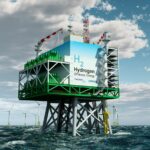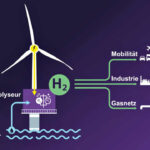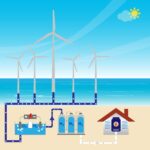Hydrogen - today and in the future
The northern German states are committed to the global and national climate protection goals. The internationally recognised climate goals require limiting global warming to well below two degrees. To achieve this, greenhouse gas emissions must be reduced sustainably and the energy transition must be implemented across all sectors (electricity, mobility, industry, households). Further challenges for today’s economies and lifestyles are, especially in urban centres, e.g. air pollution and noise pollution as well as requirements for sustainability in the use of resources.
Green hydrogen necessary for achieving climate goals
Besides the electricity sector, the share of renewable energies has been stagnating for years. The substitution of fossil energy sources with hydrogen produced from renewable energies (hereafter: green hydrogen) or synthetic energy sources based on it offers an opportunity to implement the energy transition in sectors that are difficult to access for direct electrification for technical or economic reasons. Various current studies have come to the conclusion that a substantial part of the total greenhouse gas emissions cannot be avoided through the use of electricity, but predominantly requires either green hydrogen directly or an energy carrier based on it. Furthermore, the electrolytic production of hydrogen also represents a flexibility option that can be used to stabilise the electricity grids and temporarily reduce existing grid bottlenecks.
Hydrogen technology is mature
The use of hydrogen is not generally breaking new ground. Hydrogen has long played an important role as a feedstock and process gas in industrial applications, for example in fertiliser production, in refinery processes or in the chemical industry. For today’s industrial needs, hydrogen is mostly used, which is either produced from fossil natural gas (e.g. by steam reforming) or as a by-product in other industrial processes (e.g. chlor-alkali electrolysis). In addition, the production of hydrogen by means of electrolytic splitting of water, also based on renewable energies, is a technologically mature process.
Future application possibilities
New, however, are additional application possibilities for green hydrogen in connection with the energy transition and the use of renewable electricity for hydrogen electrolysis (as a load that can be switched on/off) that is as close to the grid as possible, which are currently under discussion. From a purely technical point of view, green hydrogen can potentially be used in a wide variety of ways, be it
- as a substitute for the fossil-based hydrogen used up to now and
- for direct use (power-to-hydrogen) for applications that have not used hydrogen up to now, e.g. in mobility, in industrial processes (e.g. steel production), in fuel cell heat exchangers, in the production of electricity, or in the production of electricity from renewable sources. steel production), in fuel cell heating systems, in the building sector for system integration for electricity and heat, for long-term electricity storage and reverse power generation or
- the use of green hydrogen for the synthesis of further energy carriers, fuels or other chemical compounds (power-to-gas, power-to-liquid, power-to-chemicals), each of which also has very broad fields of application.
In addition, the use of hydrogen fuel cells, for example in buses, cars, trucks and trains, not only reduces emissions of air pollutants and noise compared to conventional combustion drives, but also offers advantages over purely battery-powered electric vehicles in terms of range and duration of the refuelling process. Hydrogen drives are therefore also particularly suitable for passenger transport with taxis, rental cars or new, so-called “pooling transport”.
Hydrogen infrastructure required
For the new applications of hydrogen, significantly larger quantities of hydrogen will have to be produced in the future – and on the basis of renewable electricity. Furthermore, there is a need for storage, transport, distribution of the hydrogen, possibly corresponding possibilities for further processing as well as the necessary services (e.g. project planning, financing, maintenance). Technical solutions exist for each of these stages. In addition, intensive research is currently being conducted on the topic, so that further innovations can be expected. If the full potential of green hydrogen is to be exploited, an entire value chain must be established: a green hydrogen economy, i.e. from the production of renewable electricity to the conversion into green hydrogen and further synthetic fuels made from it, including the production of plants and components, to the marketing and application of hydrogen and its downstream products in the region. The dena lead study5 assumes an electrolysis capacity of 15 gigawatts in Germany for 2030, which is why “a corresponding expansion must begin promptly”.



